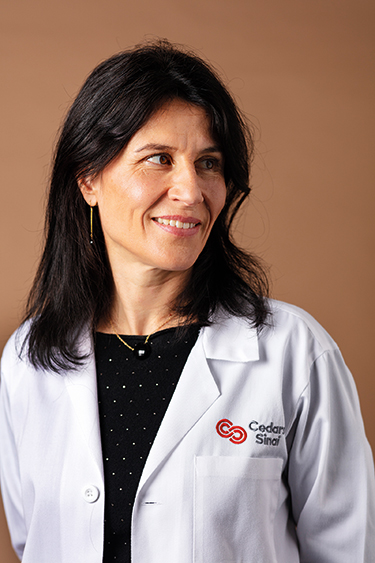Discoveries
New Surgery Chair Leads with Collaboration
Jun 08, 2023 Koren Wetmore. Photograph by Al Cuizon.

Cristina R. Ferrone, MD
She never wanted to be a surgeon. Then in medical school she discovered that she belonged in the operating arena: the teamwork, the challenge, the problem-solving and helping patients all thrilled her. Today, Cristina R. Ferrone, MD, is an accomplished surgical oncologist and chair of the Cedars-Sinai Department of Surgery. A specialist in the care of patients with complex hepato-pancreaticobiliary disease, she has pioneered novel minimally invasive surgical techniques and developed immunotherapeutic strategies for treating cancers of the pancreas, liver and biliary system. Here she shares how collaboration improves patient outcomes and what she envisions for the future of surgery at Cedars-Sinai.
Q: Why did you choose to specialize in treating pancreatic and hepatobiliary cancers?
Dr. Ferrone: That really comes down to four things: the influence of amazing mentors, the technical challenge of the surgeries, an interest in the biology of the cancers and the knowledge that not many treatment options were available for patients with these malignancies.
Q: What research have you been pursuing and why is it so vital?
Dr. Ferrone: I spend most of my time thinking about and working on treatment options for pancreatic, bile duct and liver cancers—exploring the biology of the diseases and studying the immunologic responses and gene-expression patterns of these diseases. This helps us understand what mutations occur and how to manipulate the immune system to target them. These treatments not only allow us to help patients live longer and feel better but also enable us to operate on more people. A deeper understanding of the biology allows us to downstage locally advanced patients. With targeted therapy, tumors shrink in size and move away from critical blood vessels, so we can remove the cancer.
Patient care improves because communication between the providers improves."
Q: What role does collaboration play in improving patient outcomes?
Dr. Ferrone: It’s the central tenet. It allows us to attack cancer in a multidimensional way that takes advantage of everyone’s knowledge and expertise. That means whoever is involved—surgeons, medical oncologists, radiation oncologists—we are seeing patients together and having conversations when reviewing patient charts. Patient care improves because communication between the providers improves.
Q: What new techniques and technologies may transform surgery in the near future?
Dr. Ferrone: Advancements in surgical techniques and instrumentation and the use of 3D imaging for preoperative planning will improve surgical safety.
Q: Looking forward 10 years, what do you envision for the surgical program at Cedars-Sinai?
Dr. Ferrone: Cedars-Sinai has an amazing surgical faculty. My goal, in collaboration with the other department and hospital leaders, is to further build our academic productivity and mission. I’d like to provide the infrastructure to run more clinical trials that utilize the large, diverse, local and regional patient population we serve. It’s really doing research bedside to bench back to bedside.


